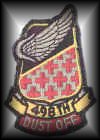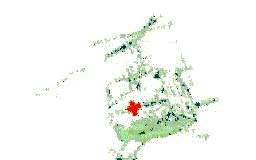
by Bruce Knipe-DUSTOFF 65 Medic
A couple of weeks ago I contacted you in regards to
the story on the 498th web site concerning the
Rescue of Dustoff 65.
I was absolutely flabbergasted to read Tim Lickness'
and later John Cook's account of my misadventures.
I thank you and others for "givin a damn" and taking the
time operate the 498th web sites.
Attached is my
part of the Dustoff 65 story and a photo that I
have been carrying around for thirty years.
Again,
Thanks!!
The Other End of the Hoist
A picture of a picture that was on the wall at Hunter
Liggett Army Airfield-the original seems to be from
Life Magazine.
Taken by a photographer on the
ground during a previous hoist operation in support
of the 101st Airborne Div.
ANOTHER VIEW TO THE RESCUE OF DUSTOFF 65
On searching cyberspace I found the 498th Dustoff
web site and was shocked to read Tim Lickness'
article "The Rescue of Dustoff 65".
A week later I read John Cook's Rescue Under Fire:
The Story of Dustoff in Vietnam and again I was
overwhelmed.
I want to thank Tim and John for
their efforts at recording the events of
April 3-6, 1968.
I was the medic on board Dustoff 65 and I would like
to share my memories from an
another viewpoint:
the Infantryman who rescued us.
To begin my story of the Infantryman of the "1st of
the Eagle" and Dustoff 65, I need to go back in time
a couple of weeks.
The first night of the Tet offensive, Dustoff 65,
1LT Charles "aka Michael" T. Meyer IV,
1LT Ben M.
Knisely,
Sgt (PP) James E. Richardson,
and SP5
Bruce A. Knipe,
left An Son for the Battle of Hue
with the sky lit up from the explosions at the Qui Nhon
Ammo Dump.
We stopped at Da Nang but were quickly
dispatched to meet up with the 101st Airborne near
the City of Hue at Camp Eagle.
The 1st Brigade,
101st AB Infantry Companies were constantly in
contact with NVA & VC troops in the hilly jungle that
bordered the city and the Perfume River.
During this
period, the term "hot landing zone" took on new
meaning.
Before, there were cold and hot LZs,
during Tet there were degrees of hot ranging from
"kinda hot but you can make it" to
"G-- D--- M----- F------ hot, but if you don't try
our folks are dead".
My first recollection of Camp Eagle was the Dustoff
helicopter bunker and radio shack
(the 101st provided
the helicopter a sandbagged protected area, but the
crew was on their own).
The radio shack served
several distinctly different purposes: dispatching
Dustoff and coordinating the Hue Alternate
Procurement System.
Why else were Navy truck
drivers showing up asking an Army SSgt where to
dump a load of wood and what items were they to
pick up and deliver to some Marine Sergeant across
base.
The most inspiring transaction was the theft
and near instant distribution of a whole truckload
of USMC beer.
I didn't actually see the heist go
down, but Richardson came out to our helicopter
with a case of beer and told me to be cool and say
nothing.
Shortly, Marine Officers and the
accompanying MPs started a tent by tent, vehicle by
vehicle, search of Camp Eagle.
The whole time that
the search was going on there were heavily loaded
and "buttoned up" 101st slicks leaving.
The Marines were pissed, but I was impressed with
the 101st logistical expertise.
Slow days were rare. More then likely, Dustoff 65's
day started early and ended after dark.
One day,
the 18th MASH was overwhelmed with casualties and we
were diverted to an USN Hospital Ship.
I believe
that it was Meyer and Knisley's first landing on the
fantail of a moving ship and I think they did an
"adequate" job.
Further, it is my belief that the
guy with the paddles directing our landing,
over-reacted when he jumped off the landing deck
into the safety nets.
But that's Meyer and Knisely's
story, not mine.
My story involves Richardson and
the hamburgers.
After off-loading the patients,
we were surprised by a sailor that presented us with
hot meals
(you need to know that the Army never ran
up to helicopter crews preparing to take off in order
to ensure that they were properly fed).
In the back of the helicopter we were getting ready
for another hot LZ and eating was the last thing
on our minds. So the hamburgers just sat there.
As usual, 18 minutes later we were again picking up
wounded paratroopers, but this time we shocked the
hell out of an 101st Medic.
Just as we finished
loading patients (I slung and Richardson blocked
them from going out the other door - no room for
litters)
Richardson poked me and pointed at the
hamburgers. I took the two still warm hamburgers
from their bag and handed them to an open-mouthed
Medic who had probably not seen a hamburger since
being Stateside.
Not all Dustoff operations are glamorous or readily
capable of being retold.
The Rescue of Dustoff 65
clearly falls in the category of pain and suffering.
As I remember the situation, we knew that we were
going to take hits because we were wearing our breast
armor instead of sitting on them
(unlike up front in
the pilot's area, in the rear of a Huey the bullets
come from below, not from the front or side).
On this day there was no place to hide. The trees
were too big and tall to lawn mower our way in.
We simply hovered and I ran out the hoist cable and
jungle penetrator. I sure pray that no one down there
had time to get on the penetrator.
There was a 50/50
chance which side of the helicopter was facing the
NVA gunner and Richardson lost big time.
Richardson
was killed when he was blown out of the aircraft into
the trees.
On the other hand, Cook's description of
my getting "blown out of the aircraft" is a bit of
stretch (page 120) because on this occasion I was
wearing my monkey tail attached to the chopper on a
short leash.
I was able to scramble back into the
aircraft and still have time to prepare to die.
From that point on, I only remember fire and pain.
I owe my life to Meyer or Knisely, or both,
for getting our half of the helicopter down to the
ground without getting killed.
But fun and games
did not stop there. I was well torn up, but highly
motivated to evacuate the crash.
As I lay on the
ground, I witnessed Meyer repeatedly try to rescue
Knisely from the burning chopper. His success was
truly heroic.
We could not find Richardson and
until reading Lickness' account, I did not know that
his body was recovered days later.
There is one
thing I know for sure; you can easily tell the
difference between the sound of NVA troops and
American paratroopers that are looking for you.
Lt Lickness, in his article, is far too modest when
it comes to the courage of his troops and he kindly
did not mention the fact that it cost his folks a
lot more to rescue us, than they would have gotten
if we had been successful in our mission.
There is also no doubt in my mind what the
consequences were of Lickness' unit not winning
that race to rescue us.
By the time Lickness'
platoon had gotten the three of us back to the main
group on some nameless hilltop in a seamless jungle,
it was dark.
The year before, I had been a field
medic with the B Comp. 2nd Bn 8th Infantry,
4th Infantry Division, and I had seen night fire
fights.
At night, it seemed that our fiery crash
and rescue had attracted the attention of every NVA
south of the DMZ.
Needless to say, it was a loud
and colorful night. In the morning the same hoist
operation was repeated, but this time Dustoff 65's
crew were the folks being saved
For a long time I have not dealt with Richardson's
death and my less than spectacular performance.
On seeing Tim Lickness' article, I was moved to
personally acknowledge and thank him for his efforts
at recording a "mission that will not be mentioned
when the great books of the era are written".
I do not know if Tim was aware that a Life Magazine
Photographer (?) was accompanying one of his
battalion's other companies a couple days earlier,
during a different hoist operation.
The photographer took this picture of what was at
the other end of the hoist.
I think everyone who
has, or now flies combat rescue, needs to see why
we do the job.
I would also like to thank John
Cook for recording the stories of Dustoff in
Vietnam.
Note to Readers:
I know that Richardson was married,
but I do not know if he had children.
Maybe his
parents are still alive.
Does someone out there
in the Web know how you find out these things and
how these stories can be passed on them?
Also does anyone know the whereabouts of Lickness,
Meyer, or Knisely?
I can be reached by way of 498th Dustoff Forum-address
messages to: bknipe

Bruce:
Thank you for sharing your story.
Some more pieces of the puzzle of Viet Nam have been
added.
I believe I knew Sgt. Richardson at Nha Trang and
Lane Field.
He was a mechanic, as I recall, and
didn't fly during his first year in country.
I heard about his being killed when I returned to the
states and Hunter Army Airfield at Savannah.
HOME
498TH DUSTOFF LINKS
NEW PHOTO PAGE 67/68 by g.a.rawles
RESCUE do65-tim lickness